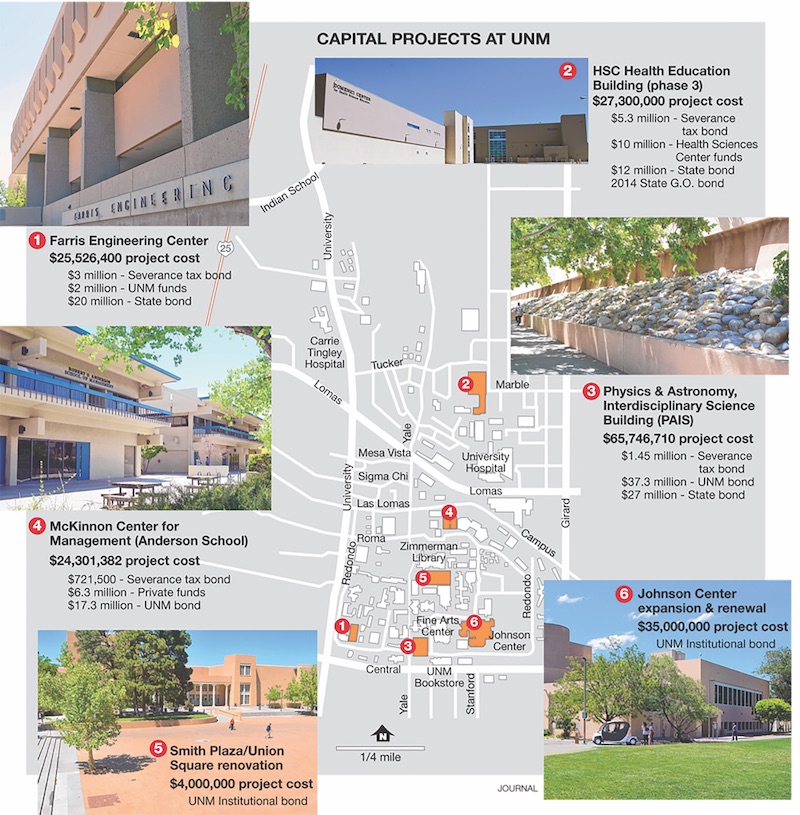Campus construction and renovation projects often come with hefty price tags. A few years ago, Duke University spent nearly $80 million on a new dining hall. Two recent projects that SmithGroupJJR designed include the $50 million Mike Ilitch School of Business at Wayne State University, now under construction in downtown Detroit, and the $82 million, 188,000-sf University of Wisconsin–LaCrosse Instructional Science Facility, a combination of allied health and STEM that will open next year.
As colleges sign off on ever-more-extravagant physical plant to help in their recruitment efforts, tuition hikes are putting college beyond the financial reach of the high school students they are trying to attract.
But colleges and universities are adept at tapping a variety of sources—taxpayers, investors, donors, and, yes, students—to fund their growth ambitions.
Bonds are one time-tested route. The University of New Mexico’s five-building construction program is being paid for primarily with bonds. Last year, North Carolina completed a $2 billion issue of Connect Bonds, $1.33 billion of which are earmarked for the 17 colleges in its UNC system.
Other colleges are asking their student bodies to approve annual user fees that would defray the cost of planned construction and renovation before the work gets started.
 The University of New Mexico’s five-building construction program is being financed by a combination of bonds, student fees, school funds, and private donations. Courtesy University of New Mexico.
The University of New Mexico’s five-building construction program is being financed by a combination of bonds, student fees, school funds, and private donations. Courtesy University of New Mexico.
State governments are also willing to finance college construction, albeit on a limited basis. Supplemental funding by the Massachusetts State Legislature helped pay for the $52 million, 87,500-sf Design Building at the University of Massachusetts Amherst, which had its official ribbon cutting in April. This is the first cross-laminated timber academic building in the U.S.
Greggrey Cohen, Simpson, Gumpertz & Heger’s National Practice Leader for structural repair and rehabilitation, who worked on the UMass Design Building, says that in recent years there has been a “big push” among colleges and universities in the Bay State to replace older buildings.
“The underlying strategy of our capital plan is to target investment in the areas of the highest impact, while balancing these investments across deferred maintenance, modernization, and new construction,” says Shane Conklin, UMass’s Associate Vice Chancellor for Facilities and Campus Services. Construction projects scheduled to open in the next two years include the relocation of a physical sciences building that will be integrated with a new 95,000-sf research building for chemistry and physics.
This isn’t to say that colleges and universities have unlimited access to capital. And their “reno-first” inclinations are a sign of their budgetary constraints.
“Everyone is still money conscious,” says Robert Quigley, of Architectural Resources Cambridge. His firm went through numerous meetings with Bentley University’s board before its Jennison Hall renovation budget got approved. “They are also conscious of the mistakes they made in the past being cheap,” he says. “They want to do a quality job.”
Related Stories
| Aug 11, 2010
JanCom Technologies expands headquarters
JanCom Technologies, Inc., an Austin, Texas-based technology, infrastructure, audio-visual, and critical power systems consulting and engineering services firm, continues to grow due to an influx of high-profile international projects. The company recently expanded to a 5,000-square-foot office space at 206 Wild Basin Road. The move represents a 2,000-square-foot increase in space to accommodate the company’s growth.
| Aug 11, 2010
Rouss & Robertson Halls
University of Virginia McIntire School of Commerce
Charlottesville, Va.
Rouss Hall, a historic 24,000-sf building designed by Stanford White, served as the home of the University of Virginia’s McIntire School of Commerce from 1955 to 1975. Thirty years later, the university unveiled plans to have the business school return to the small, outdated 110-year-old facility, but this time with the addition of a 132,000-sf companion building to be named Robertson Hall.
| Aug 11, 2010
Architecture Billings Index flat in May, according to AIA
After a slight decline in April, the Architecture Billings Index was up a tenth of a point to 42.9 in May. As a leading economic indicator of construction activity, the ABI reflects the approximate nine to twelve month lag time between architecture billings and construction spending. Any score above 50 indicates an increase in billings.
| Aug 11, 2010
Construction employment declined in 333 of 352 metro areas in June
Construction employment declined in all but 19 communities nationwide this June as compared to June-2008, according to a new analysis of metropolitan-area employment data released today by the Associated General Contractors of America. The analysis shows that few places in America have been spared the widespread downturn in construction employment over the past year.
| Aug 11, 2010
Jacobs, Hensel Phelps among the nation's 50 largest design-build contractors
A ranking of the Top 50 Design-Build Contractors based on Building Design+Construction's 2009 Giants 300 survey. For more Giants 300 rankings, visit http://www.BDCnetwork.com/Giants
| Aug 11, 2010
Bowdoin College has country's first newly constructed LEED-certified ice arena
Bowdoin College's new Sidney J. Watson Arena, dedicated January 18, 2009, has become the first newly constructed ice arena in the United States to earn coveted LEED (Leadership in Energy and Environmental Design) certification from the United States Green Building Council (USGBC).
| Aug 11, 2010
Steel Joist Institute announces 2009 Design Awards
The Steel Joist Institute is now accepting entries for its 2009 Design Awards. The winning entries will be announced in November 2009 and the company with the winning project in each category will be awarded a $2,000 scholarship in its name to a school of its choice for an engineering student.
| Aug 11, 2010
Arup, SOM top BD+C's ranking of the country's largest mixed-use design firms
A ranking of the Top 75 Mixed-Use Design Firms based on Building Design+Construction's 2009 Giants 300 survey. For more Giants 300 rankings, visit http://www.BDCnetwork.com/Giants







